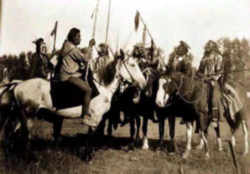


Rhode Island Early History
First Early Inhabitants of Rhode Island

Early history examines the archaeological record that tells the story of the first inhabitants of Rhode Island. Learn about the prehistory and culture of the first early inhabitants, and what lessons it might teach us about the early history of Rhode Island.
Rhode Island First Early Inhabitants Timeline
- 10,000 BC - Paleo-Indian Era (Stone Age culture) the earliest human inhabitants of America who lived in caves and were Nomadic hunters of large game including the Great Mammoth and giant bison.
- 7000 BC - Archaic Period in which people built basic shelters and made stone weapons and stone tools
- 1000 AD - Woodland Period - homes were established along rivers and trade exchange systems and burial systems were established
- 1675-1676 - King Philip's War. so named after Metacom (King Philip) of the Wampanoag tribe, who was called Philip by the English. The war was bloody and bitterly fought by the colonists against the Wampanoags, Narragansetts, Nipmucks, Pocumtucks, and Abenakis. The Narragansett tribe were nearly exterminated during this War.
- 1688 - 1763 - The French and Indian Wars between France and Great Britain for lands in North America consisting of King William's War (1688-1699), Queen Anne's War (1702-1713), King George's War (1744 - 1748) and the French and Indian War aka the Seven Years War (1754-1763)
- 1754 - 1763 - The French Indian War is won by Great Britain against the French so ending the series of conflicts known as the French and Indian Wars
- 1763 - Treaty of Paris
Early History of Native Americans in Rhode Island
The Indigenous People of Rhode Island
The names of the Rhode Island tribes included the Nipmuc, Pequot, Wampanoag and Narraganset.
Native people occupied Rhode Island for thousands of years before explorers and settlers from Europe came to North America. The Narragansett tribe
was the largest and occupied the greatest area of land. The Narragansett were part of loosely organized confederation of tribes called the Algonquin,
with settlements up and down the East coast of North America. Other groups of Algonquin, some allied with the Narragansett, and some enemies, also
lived in the area that would become Rhode Island.
Other tribal people who lived on many of the islands in the bay, including the Wampanoag, the Cowesett, the Shawoment, the Nipmuck, the Niantic, and
the Pequot, also lived in the area.
Experts believe that around 7,000 Narragansett Indians lived in the area at the time the first European settlers arrived. The native tribes farmed
the land and also fished and hunted. Women were responsible for planting, harvesting, preparing the food, gathering shellfish, and the building of
the bark huts the people lived in. Men, on the other hand, spent much of their time in recreational activities, and assisted the women with fishing
and hunting. Men called "sachems"l ed small villages of Indians who lived in family groups. Each village owed allegiance to two chief sachems who inherited
their positions.
Soon after the arrival of European settlers, famine and diseases brought by the new settlers greatly reduced the number of native people in the area.
In 1676, the killing of Metacom, the Wampanoag chief, by an Indian allied with white settlers, ended the worst of the conflicts between European settlers
and native people. The remaining tribes banded together and eventually came to use the tribal name Narragansett.





